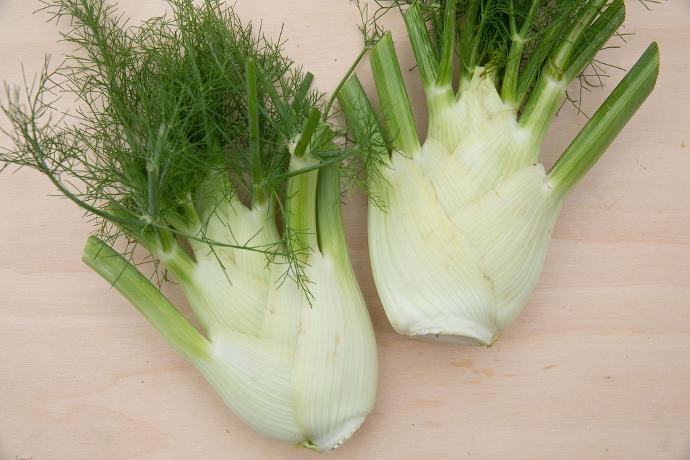Le fenouil est un légume classique et simple à cultiver. Soit on aime le goût anisé qu'il amène dans nos plats, soit on le déteste. Il y a rarement des entre deux. Pour ceux qui aiment le fenouil, nous avons d'excellentes nouvelles: le fenouil d'été est l'un des premiers légumes que vous pouvez semer au printemps!

Comment et quand semer le fenouil?
Le fenouil d'été peut être semé dès que le sol n'est plus gelé. Selon le climat et l'exposition de votre jardin, vous pourrez donc effectuer les premiers semis dès le mois de février et les échelonner jusqu'en juillet. Un semis en février vous assure une récolte dès la mi-mai!
Le semis du fenouil est facile:
- Préparez au préalable un lit de semis
- Avec le manche d'un râteau, tracez des lignes distantes de 40 cm et de 1 cm de profondeur dans le lit de semis
- Semez vos graines dans ces lignes et espacez les graines de quelques centimètres
- Refermez les sillons avec de la terre et tassez-la avec un râteau
- Arrosez votre lit de semis régulièrement durant la phase de germination (18 jours)
Les prochaines étapes
- Arrosage: Le fenouil requiert des arrosages réguliers pour une bonne croissance
- Protection contre le gel: Si un gel important est annoncé au printemps, protégez vos plantes avec un voile de paillage
- Éclaircir les rangées: quelques semaines après la germination, espacez les semis de 20 cm sur la rangée. Gardez uniquement les plantes les plus fortes pour qu'elles aient assez de place pour se développer.
- Protection des rongeurs: les rongeurs aiment le fenouil. Essayez de protéger vos plantes des souris et des campagnols.
Fenchel ist ein klassisches Gemüse, das einfach zu kultivieren ist. Entweder liebt man den Anisgeschmack, den er in unsere Gerichte bringt, oder man hasst ihn. Es gibt selten ein Dazwischen. Für alle, die Fenchel lieben, haben wir gute Neuigkeiten: Sommerfenchel ist eines der ersten Gemüse, die Sie im Frühling aussäen können!

Wie und wann säen Sie Fenchel aus?
Sommerfenchel kann gesät werden, sobald der Boden nicht mehr gefroren ist. Je nach Klima und Lage Ihres Gartens können Sie also bereits im Februar mit der Aussaat beginnen und diese bis in den Juli hinein verteilen. Eine Aussaat im Februar garantiert Ihnen eine Ernte ab Mitte Mai!
Die Aussaat von Fenchel ist einfach:
- Bereiten Sie zunächst ein Saatbett vor.
- Ziehen Sie mit dem Stiel eines Rechens, im Abstand von 40 cm und 1 cm tiefe, Linien in das Saatbett.
- Säen Sie die Samen, mit ein paar Zentimeter Abstand, in diese Linien.
- Schliessen Sie die Rillen mit Erde und drücken Sie diese mit einem Rechen fest.
- Bewässern Sie Ihr Saatbett während der Keimphase (18 Tage) regelmässig.
Die nächsten Schritte
- Bewässerung: Fenchel benötigt für ein gutes Wachstum regelmässige Bewässerung.
- Frostschutz: Wenn im Frühjahr starker Frost vorhergesagt wird, schützen Sie Ihre Pflanzen mit einem Mulchvlies.
- Ausdünnen der Reihen: Einige Wochen nach der Keimung sollten Sie die Sämlinge in der Reihe auf 20 cm ausdünnen. Behalten Sie nur die stärksten Pflanzen, damit sie genug Platz haben, um sich zu entwickeln.
- Schutz vor Nagetieren: Nagetiere lieben Fenchel. Versuchen Sie, Ihre Pflanzen vor Mäusen und Wühlmäusen zu schützen.
Fennel is a classic and simple vegetable to grow. Either we love the aniseed taste it brings to our dishes, or we hate it. There is rarely any in-between. For those who love fennel, we have great news: summer fennel is one of the first vegetables you can plant in the spring!

How and when to plant fennel?
Summer fennel can be sown as soon as the ground is no longer frozen. Depending on the climate and exposure of your garden, you can sow the first seeds in February and spread them out until July. Sowing in February ensures a harvest by mid-May!
Sowing fennel is easy:
- Prepare a seedbed beforehand
- With the handle of a rake, draw lines 40 cm apart and 1 cm deep in the seedbed
- Sow your seeds in these lines and space the seeds a few centimeters apart
- Close the furrows with soil and compact it with a rake
- Water your seedbed regularly during the germination phase (18 days)
The next steps
- Watering: Fennel requires regular watering for good growth
- Frost protection: If a heavy frost is forecasted in the spring, protect your plants with a mulch cloth
- Thinning the rows: a few weeks after germination, space the seedlings 20 cm apart in the row. Keep only the strongest plants so that they have enough room to grow.
- Rodent protection: rodents love fennel. Try to protect your plants from mice and voles.
Il finocchio è un ortaggio classico e facile da coltivare. O si ama il sapore di anice che conferisce ai piatti, o lo si odia. Raramente esiste una via di mezzo. Per chi ama il finocchio, abbiamo una grande notizia: il finocchio estivo è uno dei primi ortaggi che si possono piantare in primavera!

Come e quando seminare i finocchi?
Il finocchio estivo può essere seminato non appena il terreno non è più gelato. A seconda del clima e dell'esposizione del vostro orto, la prima semina può essere effettuata già a febbraio e fino a luglio. La semina a febbraio assicura un raccolto a partire da metà maggio!
Seminare il finocchio è facile:
- Preparare il letto di semina in anticipo
- Con il manico di un rastrello, tracciate nel semenzaio delle linee distanti 40 cm l'una dall'altra e profonde 1 cm.
- Seminate in queste linee e distanziate i semi di qualche centimetro l'uno dall'altro.
- Chiudete i solchi con la terra e compattatela con un rastrello.
- Innaffiate regolarmente il semenzaio durante la fase di germinazione (18 giorni).
Le fasi successive
- Irrigazione: il finocchio richiede un'irrigazione regolare per crescere bene.
- Protezione dal gelo: se in primavera sono previste forti gelate, proteggete le piante con un telo pacciamante.
- Diradamento delle file: qualche settimana dopo la germinazione, distanziare le piantine di 20 cm l'una dall'altra nella fila. Tenete solo le piante più forti in modo che abbiano spazio sufficiente per crescere.
- Protezione dai roditori: i roditori amano il finocchio. Cercate di proteggere le piante da topi e arvicole.




Sow summer fennel starting in February